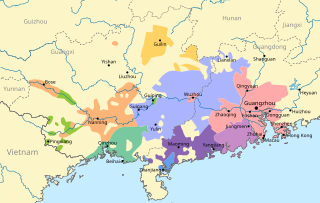Goulou is one of the principal groups of Yue dialects. It is spoken around the Guangxi–Guangdong border, and includes the dialects of Yulin and Bobai.
| Goulou | |
|---|---|
| 勾漏方言 Ngaulau Yut | |
| Native to | Southern China |
| Region | Guangxi–Guangdong border |
Native speakers | (6.9 million cited 1998)[1] |
| Language codes | |
| ISO 639-3 | None (mis) |
| ISO 639-6 | gulu |
| Glottolog | Noneguin1237 Goulou |
| Linguasphere | 79-AAA-me |
 Goulou, among other Yue and Pinghua groups in Guangxi and Guangdong | |
Dialects
editYulin dialect is representative, though Bobai is better known.
Phonology
editInitials
edit| Labial | Alveolar | Palatal | Velar | Glottal | ||
|---|---|---|---|---|---|---|
| Stop/ Affricate |
voiceless | p | t | tʃ | k | (ʔ) |
| aspirated | pʰ | tʰ | tʃʰ | kʰ | ||
| implosive | ɓ | ɗ | ||||
| Nasal | m | n | ɲ | ŋ | ||
| Fricative | voiceless | f | ʃ | h | ||
| voiced | v | |||||
| lateral | ɬ | |||||
| Approximant | voiced | l | j | |||
| labial | ɥ | w | ||||
Finals
edit| Front | Central | Back | ||
|---|---|---|---|---|
| unrounded | rounded | |||
| Close | i | y | u | |
| Close-mid | e | ø | o | |
| Open-mid | ɛ | œ | ɔ | |
| Near-open | ɐ | |||
| Open | a | |||
- Close vowel sounds may alternate between close vowel sounds [i, y, u] and near-close vowel sounds [ɪ, ʏ, ʊ].[2]
| Oral | Nasal | Stop | |||||||||
|---|---|---|---|---|---|---|---|---|---|---|---|
| Medial | coda | i | y | u | m | n | ŋ | p | t | k | |
| Nucleus | Vowel | a | ai | au | am | an | aŋ | ap | at | ak | |
| wa | wai | wan | wat | ||||||||
| ɐi | ɐu | ɐm | ɐn | ɐŋ | ɐp | ɐt | ɐk | ||||
| wɐi | wɐn | wɐt | |||||||||
| i(ɛ) | iɛu | iɛm | iɛŋ | iɛp | iɛk | ||||||
| (ei) | eŋ | ek | |||||||||
| wek | |||||||||||
| i | iu | im | in | ip | it | ||||||
| œ | |||||||||||
| øy | |||||||||||
| y | |||||||||||
| ɔ | ɔi | ɔm | ɔn | ɔŋ | ɔp | ɔt | ɔk | ||||
| ou | oŋ | ok | |||||||||
| u | ui | un | ut | ||||||||
Tone
editBobai dialect is widely cited as having the most tones of any variety of Chinese, though it actually only has six, the same as most Yue dialects. The reason for the claim is that Bobai makes a four-way tonal distinction in checked syllables, whereas most other Yue dialects have three. In Yulin dialect just to the north of Bobai, however, neither entering tone is split: there are just two entering tones, 7 and 8. Lee (1993) believes that Bobai is innovative in having split 8, whereas Yulin (along with several neighboring interior Yue dialects) is innovative in having merged a former split in 7: proto-Yue probably had 7a, 7b, and 8.
Many Yue varieties exhibit a "changed tone" with some semantic content. Such tones occur in the Yulin dialect, in checked syllables only, marking diminutives. In such cases, the final stop -p, -t or -k is changed to a homorganic nasal -m, -n or -ŋ, respectively, and the pitch contour is also altered. This seems to be a trace of a now-lost suffix similar to ér (兒, Middle Chinese nye) in other Chinese varieties.[3]
References
editCitations
edit- ^ Olson, An Ethnohistorical Dictionary of China
- ^ a b c Hashimoto, Anne Yue (1971). A Guide to the Teng-xian Dialect. Princeton University, N.J. Chinese Linguistics Project.
- ^ Tan, Yutian (2011). "The origin and nature of high rising diminutive Tone Change in Siyi Dialect" (PDF). In Jing-Schmidt, Zhuo (ed.). Proceedings of the 23rd North American Conference on Chinese Linguistics (NACCL-23), Volume 2. pp. 190–207.
Sources
edit- Gina Lee, 1993. Comparative, diachronic and experimental perspectives on the interaction between tone and the vowel in Standard Cantonese
- Hashimoto, Anne Yue, 1971. A Guide to the Teng-xian Dialect. Princeton University, N.J. Chinese Linguistics Project.
- Ann Yue, 1979. The Teng-xian Dialect of Chinese: Its Phonology, Lexicon and Texts with Grammatical Notes. Computational Analysis of Asian and African Languages Monograph Series, No. 3.